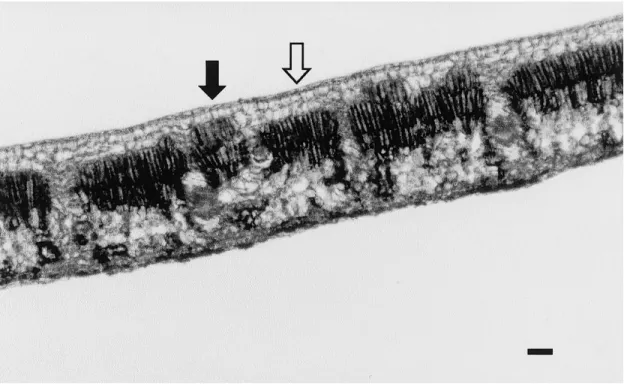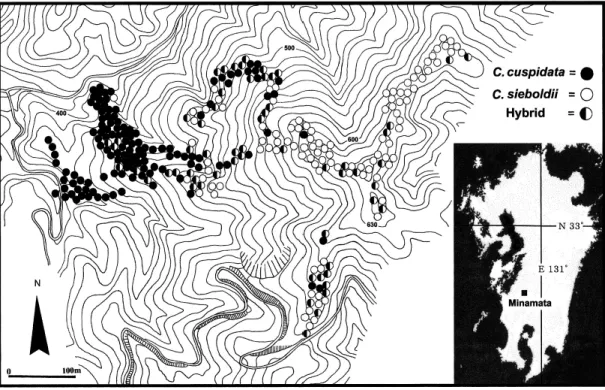Patterns of occurrence of hybrids of
Castanopsis cuspidata and C. sieboldii in the IBP Minamata Special Research Area , Kumamoto Prefecture , Japan
著者 Kobayashi Satoshi, Hiroki Shozo journal or
publication title
植物地理・分類研究 = The journal of phytogeography and toxonomy
volume 51
number 1
page range 63‑67
year 2003‑06‑25
URL http://hdl.handle.net/2297/48538
Castanopsis cuspidata(Thunb.)Schottky and C. sieboldii(Makino)Hatus. ex T. Yamaz. et Mashiba are dominant components of the ever- green broad-leaved forests of southwestern Ja- pan, including parts of Honshu, Kyushu and Shikoku but excluding the Ryukyu Islands(Hat- tori and Nakanishi 1983).Although these 2Cas- tanopsis species are both climax species, it is very difficult to distinguish them because of the existence of an intermediate type(hybrid).Cas- tanopsis cuspidata and C. sieboldii were re- garded to be varieties in the same species until it was decided thatC. sieboldii was a variety of C. cuspidata(Nakai 1939 ; Yamanaka 1966). However, Yamazaki and Mashiba(1987 a, b)clas- sified the 2 trees as separate species on the basis of differences in nut shape and leaf epidermis.
Castanopsis cuspidata has a single-layered leaf epidermis and bears small, globular nuts, whereasC. sieboldii has a 2-layered leaf epider- mis and bears large, oblong nuts(Yamazaki and Mashiba 1987 a).
A type of nut or wood morphology that is in- termediate between the 2 species is recognized
(Kobayashi and Sugawa 1959 ; Yamanaka 1966
; Yamazaki and Mashiba 1987 a). On the basis of its wood anatomy, Kobayashi and Sugawa
(1959)suggested that the intermediate type was a hybrid. However, Yamanaka(1966)considered that the intermediate type was merely an intras- pecific variation. By comparing its nut shape with the typical nut shape of each species, Hi- roki and Ichino(1991)showed that individuals with the intermediate type of nut that were growing around temples and shrines in the Chubu District were hybrids of the 2 species.
However, it is difficult to identify the hybrids by nut morphology alone, because the nut shapes of the 2 species are variable and can overlap with each other. Kobayashi et al.(1998)showed that hybrids have a chimeric structure of both 1 and 2 epidermal layers within a leaf. These morpho- logical differences among C. cuspidata, C. sie- boldii and their hybrid can be confirmed by ge- netic differences in nuclear species-specific markers(paper in preparation by the authors). Therefore, the morphology of the leaf epidermis is a useful key characteristic for the identifica- tion of C. cuspidata, C. sieboldii and their hy- brid.
Hiroki and Ichino(1991)reported that hybrids occurred in forests around the temples and shrines of the Mikawa District of Aichi Prefec- ture and suggested that this hybridization was caused by the planting ofC. sieboldii in the C.
cuspidata distribution area. In 2001 we sug- gested that, in the coastal areas of the Chubu District, hybrids may be growing in natural for- ests because C. sieboldii coexists with C. cuspi- data in these areas, although this hybrid origin is questionable because of uncertainty about the origin of the distribution ofC. sieboldii(Hiroki and Kobayashi 2001).
To conduct a thorough examination of hybridi- zation in natural forests, we chose theCastanop- sis population in the Minamata Special Research Area of the International Biological Program
(IBP), Kyushu. Although Tagawa(1973, 1979)
reported that onlyC. cuspidata is present in this area, we had received information that C. sie- boldiialso exists there(personal communication by Tagawa and Okubo in 1999). We eventually
!The Society for the Study of Phytogeography and Taxonomy 2003
Satoshi Kobayashi and Shozo Hiroki : Patterns of occurrence of hybrids of Castanopsis cuspidata and C. sieboldii in the IBP Minamata Special Research Area , Kumamoto Prefecture , Japan
Graduate School of Human Informatics, Nagoya University, Chikusa-Ku, Nagoya 464―8601, Japan
63
found that bothC. cuspidataandC. sieboldiiare distributed in the area(Omura et al. 1978). Therefore, we expected hybrids to be present too.
We also intended to investigate the distribu- tion of the 2 species to see whether the hybrid population occurred only in the region where the 2 species overlapped.
Study site and methods
In October 1999, we sampled leaves of Cas- tanopsis from 316 individuals from the foothills to the hilltops of the IBP Minamata Special Re- search Area(about 12 ha)(lat 32°30′N, long 131°35′E, 400―642 m a.s.l.)at Minamata in Ku- mamoto Prefecture, where mature forests re- main in their natural state. In this area Cas- tanopsisdominates the tree layer, accompanying Cyclobalanopsis gilva,C. salicina andMachilus
japonica, withEurya japonica in the shrub layer
(Omura et al. 1978).
The sampled leaves were transversely cross- sectioned(30-μm thickness)with a plant mi- crotome at the widest point of the leaf. The leaf epidermis was observed under a microscope(10
×20 and 10×40). Individuals with a leaf epider- mis of 1 layer, 2 layers, and both 1 and 2 layers were identified as C. cuspidata,C. sieboldii and the hybrid, respectively. All individuals sampled were recorded on a topographic map(1 : 5000).
Results and discussion
From our examination of the leaf epidermis, we identified 147 plants asC. cuspidata, 105 as C. sieboldii and 64 as hybrids(Table 1). Indi- viduals with a chimeric structure of both 1 and 2 epidermal layers within a leaf were identified as Castanopsis cuspidata Castanopsis siboldii Hybrid total
No. of individuals 147 105 64 316
Table 1. The number of individuals ofCastanopsis cuspidata, cuspidata, C.sieboldiiand hybrids found in the investigated area
Fig. 1. Leaf epidermis of a hybrid betweenCastanopsis cuspidataandC. sieboldii. Black arrow indicates 1―layered leaf epidermis ; white arrow points to 2―layered leaf epidermis. Bar = 20μm.
植物地理・分類研究 第51巻第1号 2003年6月
64
hybrids(Fig. 1). These results confirm the exis- tence ofC. sieboldiiin the Minamata Special Re- search Area, as already recorded by Omura et al.
(1978), although Tagawa(1973, 1979)referred only to the presence ofC. cuspidata. Our results also show that hybrids occur in the inland areas of Kyushu where the 2Castanopsisspecies coex- ist. Coexistence ofC. cuspidata and C. sieboldii is common in southern Kyushu(Sako and Saida 1990), so one would expect hybridization of the 2 species to occur widely.
Although we demonstrated that hybrids occur in the natural forests of Kyushu, hybrids are largely due to human influence in inland Chubu.
This is becauseC. sieboldii is not naturally dis- tributed in inland Chubu(Inami 1966), and plantedC. sieboldii are needed for hybrid forma- tion(Hiroki and Ichino 1991). Yamada and Nishimura(2000)reported the coexistence ofC.
cuspidata and C. sieboldii in the forests around temples and shrines in and around Okayama Prefecture and referred to the existence of an in- termediate type of leaf epidermis. We presume that also these hybrids originate through human
influence for the same reason as described above.
In the Minamata Special Research Area, many C. cuspidataindividuals were distributed on the lower slopes or in the valleys, and their distribu- tion was sparser at higher altitudes(Fig. 2). In contrast, C. sieboldii occurred mainly in higher areas, such as on hilltops and ridges. These re- sults are consistent with the reports of Yamanaka(1966, 1975)on Shikoku, in which C. sieboldiiwas found to be distributed inland at higher altitudes than C. cuspidata. In the Mi- namata Special Research Area, onlyC. sieboldii is distributed on the hilltops and ridges. We as- sume that C. sieboldii is more tolerant to drought stress or immature soils than C. cuspi- data. Hiroki and Ichino(1998)suggested that C. sieboldii may be able to establish itself more successfully than C. cuspidata in such stressful habitats as hilltops and ridges because larger nuts give more rapid early growth.
Hybrid occurrence is not confined to the zone where C. cuspidata and C. sieboldii meet. This suggests a long history of hybridization of the 2 species.
Fig. 2. Distribution ofCastanopsis cuspidata,C.sieboldiiand their hybrids in the IBP Minamata Special Research Area.
65
Acknowledgments
We thank Dr. H. Tagawa(President of Kago- shima Prefectural College, Kagoshima)and Dr.
K. Okubo(Shinshu University, Matsumoto)for providing us with information about the distri- bution of Castanopsis species in Minamata. We would also like to thank the late Mr. M. Nish- ioka(formerly Lecturer at Hyogo College of Medicine, Nishinomiya City)for acting as our guide in the IBP Minamata Special Research Area.
References
Hattori, T. and Nakanishi, S. 1983. Phytosoci- ological system of the Camellietea japonicae Bull. Fac. Educ., Kobe Univ.71 : 123―157.
(in Japanese with English summary)
Hiroki, S. and Ichino, K. 1991. The distribution ofCastanopsis cuspidata and its allies exam- ined from a viewpoint of fruit shape. J. Phyto- geogr. Taxon.39 : 79―86.(in Japanese with English summary)
Hiroki, S and Ichino, K. 1998. Comparison of growth habits under various light conditions between two climax species, Castanopsis sie- boldiiandCastanopsis cuspidata, with special reference to their shade tolerance. Ecol. Res.
13 : 65―72.
Hiroki, S. and Kobayashi, S. 2001. Reexamina- tion of distribution of Castanopsis cuspidata and C. sieboldii in the area on hills in and around Nagoya City. Studies in Informatics and Sciences13 : 1―8.(in Japanese with Eng- lish summary)
Inami, K. 1966. Gifuken-no-shokubutsu-chiri- gaisetsu. Gifuken-kotogakko-seibutsu-kyoiku- kenkyu-kai(ed.). Gifuken-no-shokubutsu, pp.
25―84. Taishyu Shobo, Gifu.(in Japanese)
Kobayashi, S., Hiroki, S. and Tezuka, T. 1998.
Discrimination of hybrids betweenCastanopsis cuspidata andC. sieboldii based on the struc- ture of their leaf epidermis. J. Phytogeogr.
Taxon.46 : 187―189.
Kobayashi, Y. and Sugawa, T. 1959. Identifica- tion of wood of some Castanopsis in Japan.
Bull. Gov. For. Exp. Sta.118 : 139―187.(in Japanese with English summary)
Nakai, T. 1939. Castanopsis, Pasania and their allies in Japanese Empire(!). J. Jpn. Bot.
15 : 257―277.
Omura, M., Miyata, I. and Hosokawa, T. 1978.
Biological production in a warm-temperate ev- ergreen oak forest of Japan. Kira, T., Ono, Y.
and Hosokawa, T.(eds.). JIBP synthesis Vol- ume 18, pp.1―15. University of Tokyo Press, Tokyo.
Sako, S. and Saida, M. 1990. Distribution maps of Castanopsis cuspidata, C. cuspidata var.
sieboldii, Quercus gilva, Q. serrata and Cas- tanea crenata in Kagoshima proper Pref. Bull.
Kagoshima Univ. For.18 : 125.(in Japanese)
Tagawa, H. 1973. An investigation of initial re- generation in an evergreen broadleaved forest of Minamata Special Research Area of IBP. I.
Seedling production and the distribution of two dominant species. Rep. Ebino Biol. Lab., Kyushu Univ.1 : 73―80.
Tagawa, H. 1979. An investigation of initial re- generation in an evergreen broadleaved forest of Minamata Special Research Area of IBP. II.
Seedfall, seedling production, survival and age distribution of seedlings. Bull.Yokohama Phy- tosoc. Soc.16 : 379―391.
Yamada, H. and Nishimura, K. 2000. Geographi- cal distributions ofCastanopsis sieboldiiandC.
cuspidata in and around Okayama Prefecture, Japan. J. Jpn. For. Soc. 82 : 101―104.(in Japanese with English summary)
Yamanaka, T. 1966. Problems of Castanopsis cuspidata Schottky. Bull. Fac. Educ., Kochi Univ. Ser. 3, 18 : 65―73.(in Japanese with English summary)
Yamanaka, T. 1975. The Machilus thunbergii and theCastanopsis cuspidataforest in south- ern Shikoku. Bull. Fac. Educ., Kochi Univ., Ser. 3 27 : 9―15.
Yamazaki, T. and Mashiba, S. 1987 a. A tax- onomical revision of Castanopsis cuspidata
(Thunb.)Schottky and its allies in Japan, Ko- rea and Taiwan(1). J. Jpn. Bot.62 : 289―298.
(in Japanese)
Yamazaki, T. and Mashiba, S. 1987 b. A tax- onomical revision of Castanopsis cuspidata
(Thunb.)Schottky and its allies in Japan, Ko- rea and Taiwan(2). J. Jpn. Bot.62 : 332―339.
(Received November 29, 2001 ; accepted Janu- ary 27, 2003)
植物地理・分類研究 第51巻第1号 2003年6月
66
小林悟志・広木詔三:熊本県水俣市(IBP 調査地域 内)におけるツブラジイとスダジイの雑種個体群の 分布調査
天然林として知られる熊本県水俣市のIBPの調 査区域内のシイ個体群は,ツブラジイのみの分布と されていたが,スダジイが分布しているとの情報を 得た。本研究では,天然林においてツブラジイとス ダジイの交雑種がどの程度存在しているかを明らか にするため,IBP調査地域内の標高の低い山麓か
ら標高の高い尾根にかけて,任意に316個体分の 葉を採集した。葉の表皮組織の判別による結果,ツ ブラジイ(147個体)は,標高の低い山麓部に多く 存在し,スダジイ(105個体)は,山頂や尾根部に 多く存在し,雑種個体(64個体)は,山の中腹か ら尾根部にかけて分布していることが明らかになっ た。
(〒464―8601名古屋市千種区不老町 名古屋大学 大学院人間情報学研究科)
67

